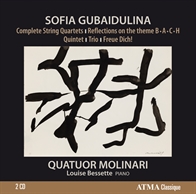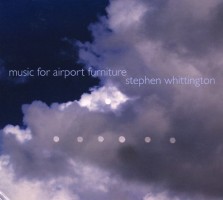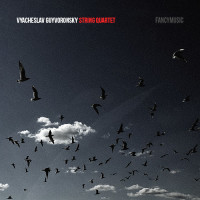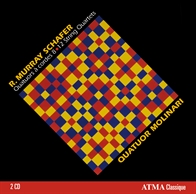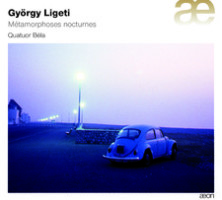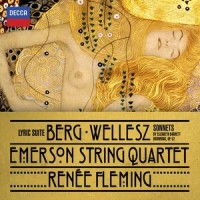String Theory 16: 17 Quartets, some with voices, tapes, etc.
|
Grant Chu Covell [January 2016.]
Sofia GUBAIDULINA: String Quartet No. 1 (1971); String Quartet No. 2 (1987); String Quartet No. 3 (1987); String Quartet No. 4 (1993); Reflections on the theme B-A-C-H (2002); Quintet for Piano and Strings (1957); String Trio (1988); Sonata for Violin and Cello, “Rejoice! (Freue Dich!)” (1981). Quatuor Molinari: Olga Ranzenhofer, Frédéric Bednarz (vln), Frédéric Lambert (vla), Pierre-Alain Bouvrette (vlc); Louise Bessette (pno). ATMA ACD2 2689 (2 CDs) (http://www.atmaclassique.com/). After wrestling with Schnittke, the Molinari get into the ring with Gubaidulina. If they had tackled just the four string quartets, we would have excellent examples of Gubaidulina’s vast depth. The additional Piano Quintet pins Gubaidulina’s innovation in the context of 20th-century Soviet music, and the duo, Rejoice!, demonstrates her philosophical and religious enthusiasms. The Molinaris are powerful advocates. No. 1 was written on the way out of a post-Stalin serialist inoculation. Gubaidulina’s mature style is in evidence: The material leads by asking questions. The work combines strict notation with freer passages. For a theatrical ending the players must gradually move away from each other as their final repeating gestures demonstrate indifference. Commissioned and created the same year, it’s possible to hear Nos. 2 and 3 as a pair, but I don’t think that was the intention. The Second is compact and severe. Its tightrope melodic lines radiate from a single note, perched just high enough so that the natural instinct is to knock them down. The Third is a larger statement (all four quartets are single movements), opening onto a gigantic expanse of pizzicato. Bowed notes appearing halfway through create canonic material rising gradually upwards. The Fourth requires that the quartet capture itself on tape playing material at a quarter-tone remove as well as gently bouncing objects (ping pong balls?) on the strings. Eventually the live quartet absorbs and extends the pre-recorded material. The Piano Quintet is the earliest composition here, its rhythm and grammar reflecting Shostakovich’s influence. Later traits are also on display: After initial melodic statements and accompaniments, Gubaidulina’s harmonies wander to dissonant corners, and frenetic passages resolve by transitioning to completely different material. The String Trio was written between the Third and Fourth quartets. That three voices can’t be equally divided lends itself well to Gubaidulina’s exploration of texture and sound production. Time stops in the central movement, only to stumble forth and get derailed yet again. The 25-minute grand duo sonata (originally for Russian giants Oleg Kagan and Natalia Gutman) expresses Gubaidulina’s religious and philosophical concerns. The five parts are titled with epigrams from Hryhorii (or Gregory) Skovoroda, a Ukrainian poet, philosopher and composer.
Stephen WHITTINGTON: Music for Airport Furniture (2011). Zephyr Quartet: Belinda Gehlert, Emily Tulloch (vln), Jason Thomas (vla), Hilary Kleinig (vlc). Cold Blue Music CD0038 (1 CD) (http://www.coldbluemusic.com/). Here’s a fresh take on “furniture music,” Satie’s designation for background music meant to be played live but not actively focused upon as one might in a concert setting. Imagine the stories airport furniture could tell: recollections of expectation or farewell, perhaps even anxiety, but most likely boredom and loneliness. Whittington’s 23-minute quartet is tonal, rich with triads and unhurried appoggiaturas suggesting longing and leisurely resolutions. Like the depicted immobile furniture, the music doesn’t actually go anywhere despite a modest build-up. Whittington strolls through cadences that Korngold or Schubert might have used. The Kronos Quartet’s recent release of Vladimir Martynov’s music comes to mind (Nonesuch 529776) more immediately than Eno’s ambient Music for Airports. (Walt considered this release here.)
Vyacheslav GUYVORONSKY: String Quartet (1986). Vladislav Pesin, Anton Levin (vln), Dmitry Yakubovsky, Mikhail Krutik (vla), Mikhail Degtyarev (vlc). FancyMusic FANCY030 (1 CD) (http://www.fancymusic.ru/). It’s easy to spin a cradle-to-grave story while trumpeter Guyvoronsky’s 50-minute quartet ambles past. Atonal and wistful, the work follows the Haydn model of first violin supported with accompaniment. Themes and recurring motives are hard to discern. The movement’s titles, Birth, Childhood, Adolescence, Youth, Anility, Death, echo that this is the “life of an ordinary man,” perhaps too ordinary. Birth and Death are unsurprisingly the longest, although unemotional. Details about genesis and intention are scarce. Squint and it sounds a bit like Stravinsky imitating improvisation. Tremolo in Death of course suggests Schubert. It’s not immediately apparent why there are two violists. Personnel details indicate that Yakubovsky takes over for just the fourth movement, Youth, while Krutik sits out. It’s clearly a solo viola plus ensemble, suggesting perhaps Yakubovsky had familiarity with the material. Absent details, we’re distracted to imagine other, practical reasons.
Murray SCHAFER: String Quartet No. 8 (2000-01)1; String Quartet No. 9 (2005)2; String Quartet No. 10, “Winter Birds” (2005)3; String Quartet No. 11 (2006)4; String Quartet No. 12 (2012)5. Odile Portugais2 (child’s voice), Quatuor Molinari: Olga Ranzenhofer1,2,3,4,5, Frédéric Bednarz2,3,4,5, Johannes Jansonius1 (vln), Frédéric Lambert2,3,4,5, David Quinn1 (vla), Pierre-Alain Bouvrette2,3,4,5, Julie Trudeau1 (vlc). ATMA ACD2 2672 (2 CDs) (http://www.atmaclasssique.com/). Schafer suggests isolation without loneliness and contemplation without misery. His is a distinctive style in a crowded field which hastily inclines towards complexity and dissonance. Quatuor Molinari extends a series begun in 2000: Nos. 1 to 7 were on ATMA ACD2 2188-89, and this No. 8 was originally issued in 2003 on ATMA ACD2 2201. The quartets are programmed so that 9, 10 and 11 are on one disc (65:31), and 12 and 8 on the other (39:19). The single movement No. 9 effortlessly incorporates a tape with children’s voices. A tune borrowed from No. 8 establishes a tranquil tone. The quartet will gradually gear up, but the chattering kids’ recurring intrusion nudges the music towards innocence. A narrator appears at the end of Winter Birds – Schafer himself – to comment upon what we’ve just heard, namely a portrait of 2005’s very cold winter (-20 to -25° C) and the scant motion of birds outside the composer’s window. In No. 11’s final movement of five, a tape contributes an Aeolian harp’s otherworldly whirr. The quartet creates tightly spaced metallic chords with minimal vibrato, and the overall effect is like an accordion. Together Nos. 9, 10 and 11 form a series. It’s evident this contemporaneous trilogy are late works, confident and cool in demeanor (and not just because at least one describes Winter). No. 12 is a different self-assured torso, unexpectedly Romantic and lush. It makes a strong first impression and might be the most conventional of these five because it suggests the early-20th century quartet literature. No. 8 is in two parts. The quartet pre-records itself so that a tape can introduce echo effects. The ensemble lineup is different, but it’s clear that both Schafer and the Molinari have matured in the more recent pieces.
György LIGETI: String Quartet No. 1, “Métamorphoses nocturnes” (1953-54); String Quartet No. 2 (1968); Sonata for solo cello (1948-53)*. Quatuor Béla: Julien Dieudegard, Frédéric Aurier (vln), Julian Boutin (vla), Luc Dedreuil* (vlc). Aeon AECD 1332 (1 CD) (http://www.aeon.fr/). Reflecting influences that the authoritarian Hungarian regime had suppressed, Ligeti’s sectional and varied First lived in a drawer for years. The piece and its composer escaped to Western Europe in 1956, and the work was premiered in Vienna in 1958. The 1968 Second is even more confident, with clouds of textures and effects that exist without formal or architectural reason, such as the pizzicato third movement. After bunking with Stockhausen and company, Ligeti quickly absorbed the mid-century avant-garde, and this quartet displays him confidently striding off into a new direction. Like the quartet pair, the two-movement cello sonata straddles past and present, however at a shorter time scale: the initial Dialogo, from 1948-49, and the latter Capriccio from 1953. Bits of Bach percolate across the lyric and more angular sections. The work was banned in Hungary and wasn’t dusted off until the late 1970s. This is a shortish (50:20) release, but Ligeti’s quartets are powerful jolts. Dedreuil dashes off what has since become a contemporary classic.
Alban BERG: Lyric Suite (1926; incl. alt. ver. Largo desolato with sop). Egon WELLESZ: Sonette der Elisabeth Barrett Browning, Op. 52 (1934). Eric ZEISL: Komm, Süsser Tod (1938; arr. J. Peter Koene). Renée Fleming (sop), Emerson String Quartet: Eugene Drucker, Philip Setzer (vln), Lawrence Dutton (vla), Paul Watkins (vlc). Decca 478 8399 (1 CD) (http://www.deccaclassics.com/). Quite possibly the Wellesz resurgence starts here. Berg’s Lyric Suite is so highly charged that listening can’t be casual. At this point, the work’s secret program (Berg documented a love affair) is well known. Fleming joins the Emersons in the alternate voice-plus-quartet version of the last movement after the complete strings-only rendition. The Wellesz is a discovery, delivered with rapt attention and finesse. It is a relief to de-emphasize the Berg, to follow the passionate, distressed Lyric Suite with Wellesz’s gravity. Fleming is perfect and the Emersons respond with nuance, if not relief. It does seem bizarre to take Browning’s Sonnets from the Portuguese into German via Rilke. The miniature Zeisl is an obscure encore, from another forgotten Austrian émigré. Komm, Süsser Tod might have been his last song written on European soil. There are no notes for this tiny piece.
[Previous Article:
Cincinnati Rides Tchaikovsky Warhorses to the Big Apple]
[Next Article:
Descending]
|
